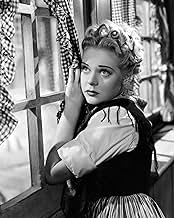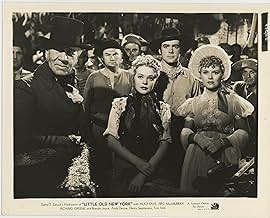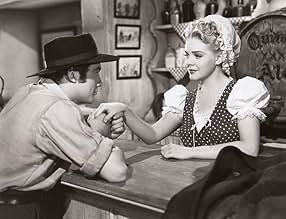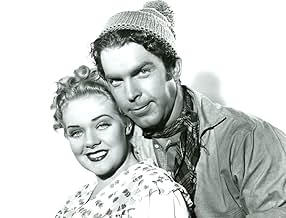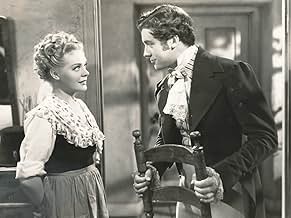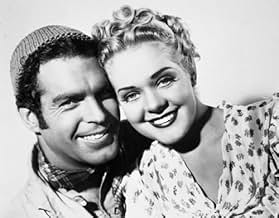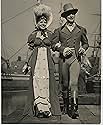CALIFICACIÓN DE IMDb
6.4/10
277
TU CALIFICACIÓN
Agrega una trama en tu idiomaSteamboat inventor Robert Fulton shows up in New York in 1807. Tavern keeper Pat O'Day believes in him, but her boyfriend doesn't. All seems lost after sailors, afraid of losing their jobs, ... Leer todoSteamboat inventor Robert Fulton shows up in New York in 1807. Tavern keeper Pat O'Day believes in him, but her boyfriend doesn't. All seems lost after sailors, afraid of losing their jobs, burn his boat.Steamboat inventor Robert Fulton shows up in New York in 1807. Tavern keeper Pat O'Day believes in him, but her boyfriend doesn't. All seems lost after sailors, afraid of losing their jobs, burn his boat.
- Dirección
- Guionistas
- Elenco
Clarence Wilson
- Willie Stout
- (as Clarence Hummel Wilson)
Theodore von Eltz
- Washington Irving
- (as Theodore Von Eltz)
Oscar 'Dutch' Hendrian
- Blackie
- (as O.G. Hendrian)
- Dirección
- Guionistas
- Todo el elenco y el equipo
- Producción, taquilla y más en IMDbPro
Opiniones destacadas
Though it probably has zip to do with the actual story of Robert Fulton and the invention and manufacture of the first steam engine this is a very pleasant little drama with light overtones. That's mainly due to the cast, all very competent performers who have a nice chemistry together.
Alice Faye, not singing this time, is full of brassy snap as the most virtuous waterfront innkeeper who never existed who longs to leave the docks behind and become a lady. She's matched by Fred MacMurray full of cheery bonhomie as a shipbuilder, the now amusingly named Charley Brownne, who has a yen for Alice. Richard Greene is a bit of a stick as Fulton but he and Brenda Joyce make an attractive pair. And Andy Devine is along to add his squeaky voiced charm as a buddy of the lead pair.
The title, an obvious attempt by Fox to conjure up thoughts of Alice's big hit of a few years before, In Old Chicago, has very little to do with the picture. You hardly see any outdoor shots of the city but the interior sets are handsomely mounted if unimaginatively lit as you'd expect for a Fox feature for their top star.
If you're looking for a history lesson about the progress of navigation during the country's early years you won't find it here but if a enjoyable diversion for about an hour and a half is what you seek this will fill the bill. Nothing spectacular but a nice hidden gem for fans of the stars.
Alice Faye, not singing this time, is full of brassy snap as the most virtuous waterfront innkeeper who never existed who longs to leave the docks behind and become a lady. She's matched by Fred MacMurray full of cheery bonhomie as a shipbuilder, the now amusingly named Charley Brownne, who has a yen for Alice. Richard Greene is a bit of a stick as Fulton but he and Brenda Joyce make an attractive pair. And Andy Devine is along to add his squeaky voiced charm as a buddy of the lead pair.
The title, an obvious attempt by Fox to conjure up thoughts of Alice's big hit of a few years before, In Old Chicago, has very little to do with the picture. You hardly see any outdoor shots of the city but the interior sets are handsomely mounted if unimaginatively lit as you'd expect for a Fox feature for their top star.
If you're looking for a history lesson about the progress of navigation during the country's early years you won't find it here but if a enjoyable diversion for about an hour and a half is what you seek this will fill the bill. Nothing spectacular but a nice hidden gem for fans of the stars.
This is an incredibly fictionalized account of the work of Robert Fulton to make the first American steamship. Alice Faye, Fred MacMurray and Ward Bond are there...even though they really were inventions of the playwright to first came up with this story. As a history lesson, it comes up lacking! What follows is sort of a comic book version of history--the sort of thing that Hollywood often did in their highly fictionalize 'true stories'.
So is this any good? Well, it looks nice. Twentieth Century-Fox made lovely looking films and the music and glitz are all present in this expensive production. It's also mildly entertaining...but slight. No great drama or comedy here...just another highly fictionalized film along the same lines as "In Old Chicago" and nothing more.
So is this any good? Well, it looks nice. Twentieth Century-Fox made lovely looking films and the music and glitz are all present in this expensive production. It's also mildly entertaining...but slight. No great drama or comedy here...just another highly fictionalized film along the same lines as "In Old Chicago" and nothing more.
"Little Old New York" is a fictional story about Robert Fulton's invention of the first successful steamboat. It is based on a 1920 Broadway play by Rida Young of the same title that ran for 308 performances. Young was a playwright who became best known for her lyrics to Victor Herbert's operetta, "Naughty Marietta."
Fulton had been living in Europe for some 20 years where he first made a living as a painter and then began working on inventions, sometimes with others. Back in the States, Fulton set out to find backing to build the first steamboat to navigate rivers. Henry Stephenson plays Robert Livingston, a former U.S. ambassador whom Fulton had met and befriended in England. Livingston helped raise the funds for Fulton's steamboat.
Richard Green plays Robert Fulton, and while the story is about his invention, it revolves mostly around another couple. Much, if not most of this is fictional, of course. Alice Faye plays Pat O'Day, a wharf front tavern owner who first is smitten by Fulton, and then helps round up support and finances for him. Her cohort in this adventure is Charles Brownne, played by Fred MacMurray. He's been Pat's beau all along.
This is a light comedy and drama about Fulton's invention. It does have some historical value, but mostly in its pictorial presentation of the docks and shipbuilding of 18th and 19th centuries, The Fox studio did a superb job in replicating the shipbuilding works of New England of the day. And in portraying the craft of shipbuilding at the time.
Fulton had been living in Europe for some 20 years where he first made a living as a painter and then began working on inventions, sometimes with others. Back in the States, Fulton set out to find backing to build the first steamboat to navigate rivers. Henry Stephenson plays Robert Livingston, a former U.S. ambassador whom Fulton had met and befriended in England. Livingston helped raise the funds for Fulton's steamboat.
Richard Green plays Robert Fulton, and while the story is about his invention, it revolves mostly around another couple. Much, if not most of this is fictional, of course. Alice Faye plays Pat O'Day, a wharf front tavern owner who first is smitten by Fulton, and then helps round up support and finances for him. Her cohort in this adventure is Charles Brownne, played by Fred MacMurray. He's been Pat's beau all along.
This is a light comedy and drama about Fulton's invention. It does have some historical value, but mostly in its pictorial presentation of the docks and shipbuilding of 18th and 19th centuries, The Fox studio did a superb job in replicating the shipbuilding works of New England of the day. And in portraying the craft of shipbuilding at the time.
This film sports winning performances (Alice Faye is delightful and very accomplished as a light comic actress), plenty of well-played comedy and well-staged action, a fine Alfred Newman score. But what really impressed and intrigued me were some elaborately staged outdoor scenes which appeared to be at least partially shot on a real 18th century seaport, not just the back lot. Either Fox spent a whole lot of money constructing a very large and realistic looking seaport set, or some of this was shot on location at some historic recreation site, or the art director was a genius in making the back lot look a lot bigger than it was. Interesting to see what a muscular hunk Fred MacMurray was, very different than his image in later years.
I only saw this film in the 1960s, and memories of it are somewhat sparse. I recall Richard Greene trying to get financing for his steamboat, and finding roadblocks by various troublemakers, mostly local sailors who realize that steam power will hurt their sail oriented business. One moment that was well handled is the burning of the original "Claremont" (the actual name of the boat was "the North River Steamboat of Claremont" - Claremont was the name of the country estate of Chancellor Robert Livingston, Fulton's backer and brother-in-law). Another moment of the film was Greene's confusing meeting with Victor Killian, introduced to him as "Mr. DeWitt" (Greene thinks it's DeWitt Clinton - Killian is actually a thug trying to create a scene in which Greene can be beaten up). Alice Faye is given a song or two to sing, and is the love interest of MacMurray (who is also momentarily jealous of Greene, but still supports the steamboat at the end).
If one is really interested in the story of this invention - our first really important invention in the industrial revolution - read James Flexner's "Steamboats Come True". The actual first inventor was John Fitch, who made a successful steamboat that ran to and from Philadelphia in 1790 - 1792). Fitch was clever, but he did not know how to make a plan of the invention that could enable him to rebuild a second working steamboat. It was a hit or miss thing with Fitch. In 1798 he committed suicide in Kentucky. Besides Fitch there were other inventors (Oliver Evans, James Rumsey), but Fulton had engineering training, and was able to make patents that could be followed to repeat his invention again and again. So 1807 is the year we usually credit for the invention of the steamboat.
Yet oddly enough this is the only sound film of Fulton's invention that was made in Hollywood. I suspect it is because the Claremont was a prototype that lacked the glamor of later vessels (those that plied the Mississippi River from 1828 - 1900), and that (with a few tourist exceptions) no longer matters to us. More films dealing with railway and car transportation have been made - even more about aviation and submarines. So I suspect there will never be a more solid look at Fulton's career as artist, submarine pioneer, and steamboat developer. There is another film where Fulton pops up: "Austerlitz", a French film made in the 1950s where Orson Welles appeared as Fulton trying (in 1804-05) to interest Napoleon I in his submarine. That's about it. Maybe one day a serious film on Fulton will be made. Until then we have "Little Old New York".
If one is really interested in the story of this invention - our first really important invention in the industrial revolution - read James Flexner's "Steamboats Come True". The actual first inventor was John Fitch, who made a successful steamboat that ran to and from Philadelphia in 1790 - 1792). Fitch was clever, but he did not know how to make a plan of the invention that could enable him to rebuild a second working steamboat. It was a hit or miss thing with Fitch. In 1798 he committed suicide in Kentucky. Besides Fitch there were other inventors (Oliver Evans, James Rumsey), but Fulton had engineering training, and was able to make patents that could be followed to repeat his invention again and again. So 1807 is the year we usually credit for the invention of the steamboat.
Yet oddly enough this is the only sound film of Fulton's invention that was made in Hollywood. I suspect it is because the Claremont was a prototype that lacked the glamor of later vessels (those that plied the Mississippi River from 1828 - 1900), and that (with a few tourist exceptions) no longer matters to us. More films dealing with railway and car transportation have been made - even more about aviation and submarines. So I suspect there will never be a more solid look at Fulton's career as artist, submarine pioneer, and steamboat developer. There is another film where Fulton pops up: "Austerlitz", a French film made in the 1950s where Orson Welles appeared as Fulton trying (in 1804-05) to interest Napoleon I in his submarine. That's about it. Maybe one day a serious film on Fulton will be made. Until then we have "Little Old New York".
¿Sabías que…?
- TriviaThe play opened on Broadway in New York City, New York, USA on 8 September 1920 and closed in June 1921 after 303 performances. The opening night cast included Genevieve Tobin as Pat O'Day, Douglas Wood, as Cornelius Vanderbuilt and Donald Meek.
- ErroresThe hairstyles of the women are from the time the film was made, not from the early 1800s.
- ConexionesReferenced in Estrellas fugaces (1940)
- Bandas sonorasWho Is the Beau of the Belle Of New York
(1940) (uncredited)
Music and Lyrics by Mack Gordon
Performed by Tyler Brooke and joined by Alice Faye and other dancing patrons of Krausmeyer's Pavillion
Selecciones populares
Inicia sesión para calificar y agrega a la lista de videos para obtener recomendaciones personalizadas
Detalles
- Fecha de lanzamiento
- País de origen
- Idioma
- También se conoce como
- Little Old New York
- Locaciones de filmación
- Productora
- Ver más créditos de la compañía en IMDbPro
- Tiempo de ejecución1 hora 40 minutos
- Color
- Relación de aspecto
- 1.37 : 1
Contribuir a esta página
Sugiere una edición o agrega el contenido que falta

Principales brechas de datos
By what name was En el viejo Nueva York (1940) officially released in India in English?
Responda
